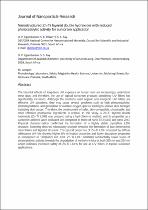 ResearchSpace
ResearchSpace
Nanostructured Zn-Ti layered double hydroxides with reduced photocatalytic activity for sunscreen application
JavaScript is disabled for your browser. Some features of this site may not work without it.
- ResearchSpace
- →
- Research Publications/Outputs
- →
- Journal Articles
- →
- View Item
| dc.contributor.author |
Egambaram, Oriela P

|
|
| dc.contributor.author |
Kesavan Pillai, Sreejarani

|
|
| dc.contributor.author |
Lategan, M

|
|
| dc.contributor.author |
Ray, Suprakas S

|
|
| dc.date.accessioned | 2019-07-30T06:52:54Z | |
| dc.date.available | 2019-07-30T06:52:54Z | |
| dc.date.issued | 2019-03 | |
| dc.identifier.citation | Egambaram, O.P., Kesavan Pillai, S., Lategan, M. et al. 2019. Nanostructured Zn-Ti layered double hydroxides with reduced photocatalytic activity for sunscreen application. Journal of Nanoparticle Research, vol 21(53): 1-12 | en_US |
| dc.identifier.issn | 1388-0764 | |
| dc.identifier.issn | 1572-896X | |
| dc.identifier.uri | https://doi.org/10.1007/s11051-019-4488-3 | |
| dc.identifier.uri | https://link.springer.com/article/10.1007/s11051-019-4488-3 | |
| dc.identifier.uri | http://hdl.handle.net/10204/11054 | |
| dc.description | Copyright: 2019 Springer Nature. Due to copyright restrictions, the attached PDF file only contains the abstract version of the full-text item. For access to the full-text item, please consult the publisher's website. The definitive version of the work is published in Journal of Nanoparticle Research, vol 21(53), doi.org/10.1007/s11051-019-4488-3. https://www.springer.com/gp/open-access/authors-rights/preprint-sharing/16718886 | en_US |
| dc.description.abstract | The harmful effects of long-term UV exposure on human skin are increasingly understood these days, and therefore, the use of topical sunscreen products containing UV filters has significantly increased. Although the currently used organic and inorganic UV filters are effective UV absorbers, they may cause several problems such as high photoreactivity, photodegradation, and generation of reactive oxygen species leading to serious skin damages including skin cancer. Therefore, the development of safer, skin-compatible, photostable, and more effective photoactive ingredients is critical. In this study, a Zn-Ti layered double hydroxide (Zn-Ti LDH) was prepared using a hydrothermal method, and its properties as a sunscreen additive were evaluated and compared to those of nano-TiO(sub2) and nano-ZnO. Physical characterization confirmed the formation of a highly stable crystalline LDH structure. Scanning electron microscopy analysis revealed the formation of two-dimensional nano-flakes and layered structure. The optical properties of Zn-Ti LDH analyzed by diffuse reflectance UV-Vis showed higher UV reflection properties and lower absorption properties in comparison to TiO(sub2) and ZnO. Zn-Ti LDH exhibited substantially lower levels of photocatalytic activity towards the degradation of methylene blue at both 365 nm and 254 nm which indicates increased safety of Zn-Ti LDHs for use as UV filters in topical sunscreen applications. | en_US |
| dc.language.iso | en | en_US |
| dc.publisher | Springer Nature | en_US |
| dc.relation.ispartofseries | Workflow;22375 | |
| dc.subject | Characterization | en_US |
| dc.subject | Nanostructured catalysts | en_US |
| dc.subject | Optical and photochemical properties | en_US |
| dc.subject | Synthesis | en_US |
| dc.subject | Zn-Ti LDH | en_US |
| dc.title | Nanostructured Zn-Ti layered double hydroxides with reduced photocatalytic activity for sunscreen application | en_US |
| dc.type | Article | en_US |
| dc.identifier.apacitation | Egambaram, O. P., Kesavan Pillai, S., Lategan, M., & Ray, S. S. (2019). Nanostructured Zn-Ti layered double hydroxides with reduced photocatalytic activity for sunscreen application. http://hdl.handle.net/10204/11054 | en_ZA |
| dc.identifier.chicagocitation | Egambaram, Oriela P, Sreejarani Kesavan Pillai, M Lategan, and Suprakas S Ray "Nanostructured Zn-Ti layered double hydroxides with reduced photocatalytic activity for sunscreen application." (2019) http://hdl.handle.net/10204/11054 | en_ZA |
| dc.identifier.vancouvercitation | Egambaram OP, Kesavan Pillai S, Lategan M, Ray SS. Nanostructured Zn-Ti layered double hydroxides with reduced photocatalytic activity for sunscreen application. 2019; http://hdl.handle.net/10204/11054. | en_ZA |
| dc.identifier.ris | TY - Article AU - Egambaram, Oriela P AU - Kesavan Pillai, Sreejarani AU - Lategan, M AU - Ray, Suprakas S AB - The harmful effects of long-term UV exposure on human skin are increasingly understood these days, and therefore, the use of topical sunscreen products containing UV filters has significantly increased. Although the currently used organic and inorganic UV filters are effective UV absorbers, they may cause several problems such as high photoreactivity, photodegradation, and generation of reactive oxygen species leading to serious skin damages including skin cancer. Therefore, the development of safer, skin-compatible, photostable, and more effective photoactive ingredients is critical. In this study, a Zn-Ti layered double hydroxide (Zn-Ti LDH) was prepared using a hydrothermal method, and its properties as a sunscreen additive were evaluated and compared to those of nano-TiO(sub2) and nano-ZnO. Physical characterization confirmed the formation of a highly stable crystalline LDH structure. Scanning electron microscopy analysis revealed the formation of two-dimensional nano-flakes and layered structure. The optical properties of Zn-Ti LDH analyzed by diffuse reflectance UV-Vis showed higher UV reflection properties and lower absorption properties in comparison to TiO(sub2) and ZnO. Zn-Ti LDH exhibited substantially lower levels of photocatalytic activity towards the degradation of methylene blue at both 365 nm and 254 nm which indicates increased safety of Zn-Ti LDHs for use as UV filters in topical sunscreen applications. DA - 2019-03 DB - ResearchSpace DP - CSIR KW - Characterization KW - Nanostructured catalysts KW - Optical and photochemical properties KW - Synthesis KW - Zn-Ti LDH LK - https://researchspace.csir.co.za PY - 2019 SM - 1388-0764 SM - 1572-896X T1 - Nanostructured Zn-Ti layered double hydroxides with reduced photocatalytic activity for sunscreen application TI - Nanostructured Zn-Ti layered double hydroxides with reduced photocatalytic activity for sunscreen application UR - http://hdl.handle.net/10204/11054 ER - | en_ZA |





